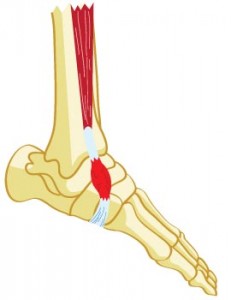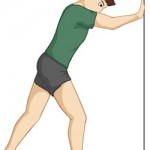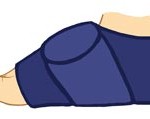 Anterior tibialis tendonitis is a common overuse injury, mostly found in middle aged or older individuals and in runners, and is most often caused by a minor trauma like spraining your ankle. The tendon’s main function is to help stabilize and pull your foot up off the ground when you walk. When inflamed, pain is often described as a sharp shooting pain along the front side of the ankle or along the top of the foot—while less severe cases say the pain is mostly a dull and achy feeling, and inflammation is found in the front of the ankle down towards the mid foot. Anterior tibialis tendonitis is mostly found in runners who favor running up hill as the tendon will stay in a contracted position for too long.
Anterior tibialis tendonitis is a common overuse injury, mostly found in middle aged or older individuals and in runners, and is most often caused by a minor trauma like spraining your ankle. The tendon’s main function is to help stabilize and pull your foot up off the ground when you walk. When inflamed, pain is often described as a sharp shooting pain along the front side of the ankle or along the top of the foot—while less severe cases say the pain is mostly a dull and achy feeling, and inflammation is found in the front of the ankle down towards the mid foot. Anterior tibialis tendonitis is mostly found in runners who favor running up hill as the tendon will stay in a contracted position for too long.
Occasionally, anterior tibialis tendonitis will be a precursor to a rupture of the tibial tendon. Except in the instance of a tendon rupture, surgery is usually not necessary, however there are some cases where non-operative management have failed despite all efforts and surgery is required to clean out the tendon and possibly lengthen the calf muscle.
Symptoms are usually aggravated by standing and walking and weakness in the ability to bring the foot upward will be noticed. If the tendon ruptures and is not treated clawing of the toes may be noticed as the tendons to the toes will be doing most of the work in elevating the foot.
Non-operative treatment is designed to limit the load through the tendon and allow the inflammation to settle.
FEEL BETTER SOONER!
Ice and cold compression are always great ways to help reduce the inflammation quickly. Buy a pair of crutches and stay off your feet! Just like bones being fractured – sprains are a fracture to the tendon and should be treated the same way. Alleviating most of the weight that’s bared on your foot during a day, by staying off of it, reducing movement will speed up the recovery process.
 Pain permitting, calf stretching should be done daily to ensure the muscles and tendons don’t continue to tighten. Stretching will also help to promote optimal blood flow. Optimal blood flow will send the perfect amount of nutrient rich blood to feed the muscles and help them heal faster. Don’t stretch if it hurts! Pain is a sign that you could be reinjuring yourself.
Pain permitting, calf stretching should be done daily to ensure the muscles and tendons don’t continue to tighten. Stretching will also help to promote optimal blood flow. Optimal blood flow will send the perfect amount of nutrient rich blood to feed the muscles and help them heal faster. Don’t stretch if it hurts! Pain is a sign that you could be reinjuring yourself.
An ankle lacer is a kind of brace that will help support up the front of the leg and provide pressure to help immobilize, stabilize and limit movement in the ankle to help prevent re-injury.
 Pain relievers should only be taken when inactive. Using a pain reliever or anti-inflammatory to help you get through the day not only will cause you to injure yourself further, you won’t know that you’ve hurt yourself until the effects of the pills have worn off. It is strongly recommended to “tough it out” during the day so that way you’re aware of what your tendon can handle.
Pain relievers should only be taken when inactive. Using a pain reliever or anti-inflammatory to help you get through the day not only will cause you to injure yourself further, you won’t know that you’ve hurt yourself until the effects of the pills have worn off. It is strongly recommended to “tough it out” during the day so that way you’re aware of what your tendon can handle.
 Corticosteroids are often recommended to help relieve pain and reduce the inflammation, but the cons outweigh the pros by far. Yes, the steroid will help to reduce pain and inflammation – but it only lasts for two to six weeks. Some of the negative things that aren’t mentioned are that with every injection you run the risk of rupturing the tendon. Once the pain is “gone” you won’t know if you’re injuring yourself further!
Corticosteroids are often recommended to help relieve pain and reduce the inflammation, but the cons outweigh the pros by far. Yes, the steroid will help to reduce pain and inflammation – but it only lasts for two to six weeks. Some of the negative things that aren’t mentioned are that with every injection you run the risk of rupturing the tendon. Once the pain is “gone” you won’t know if you’re injuring yourself further!

[…] Anterior Tibial Tendonitis […]